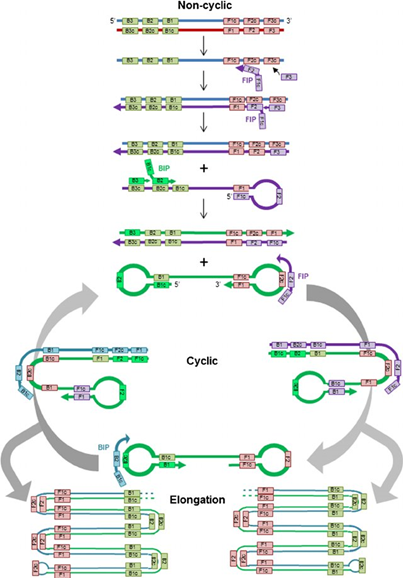
Loop-Mediated Isothermic Amplification
۲۵ آذر، ۱۴۰۱
DNA ویروسی باستانی در ژنوم انسان از عفونت ها محافظت می کند
۲۵ آذر، ۱۴۰۱Loop-mediated isothermal amplification (LAMP) is an isothermal method that relies on autocycling strand displacement DNA synthesis by Bst DNA polymerase and a set of four to six primers. Two inner and two outer primers define the target sequence; an additional set of loop primers is added to increase the speed of amplification . This is classically a two-step process, with the first step involving the production of the self-hybridizing loop structures and the second step being cycle amplification. The final products of the LAMP reaction are multimeric DNA molecules, with a cauliflower-like structure of multiple loops consisting of repeats of the target LAMP. Amplification products can be visualized in agarose gels after electrophoresis and staining with ethidium bromide or SYBR Green. The products can also be analyzed in real time by monitoring turbidity since a precipitate is created when the pyrophosphate ion released from deoxynucleotide triphosphate incorporation by DNA polymerase precipitates with magnesium ions included in the reaction buffer. Real-time monitoring using fluorescence and quencher technologies has also been leveraged for LAMP. sequence. There are multiple ways to visualize the products created by LAMP. Amplification products can be visualized in agarose gels after electrophoresis and staining with ethidium bromide or SYBR Green. The products can also be analyzed in real time by monitoring turbidity since a precipitate is created when the pyrophosphate ion released from deoxynucleotide triphosphate incorporation by DNA polymerase precipitates with magnesium ions included in the reaction buffer. Real-time monitoring using fluorescence and quencher technologies has also been leveraged for LAMP
Because LAMP is an isothermal process and positive reactions can be detected by simple turbidity measurements or direct visualization, it can be performed using no expensive equipment. For the detection of fluorescence, portable isothermal fluorometers are commercially available. These attributes make it an attractive technology for resource-poor settings and field use
Reference: Henry’s Clinical Diagnosis and Management by Laboratory Methods 24th Edition



